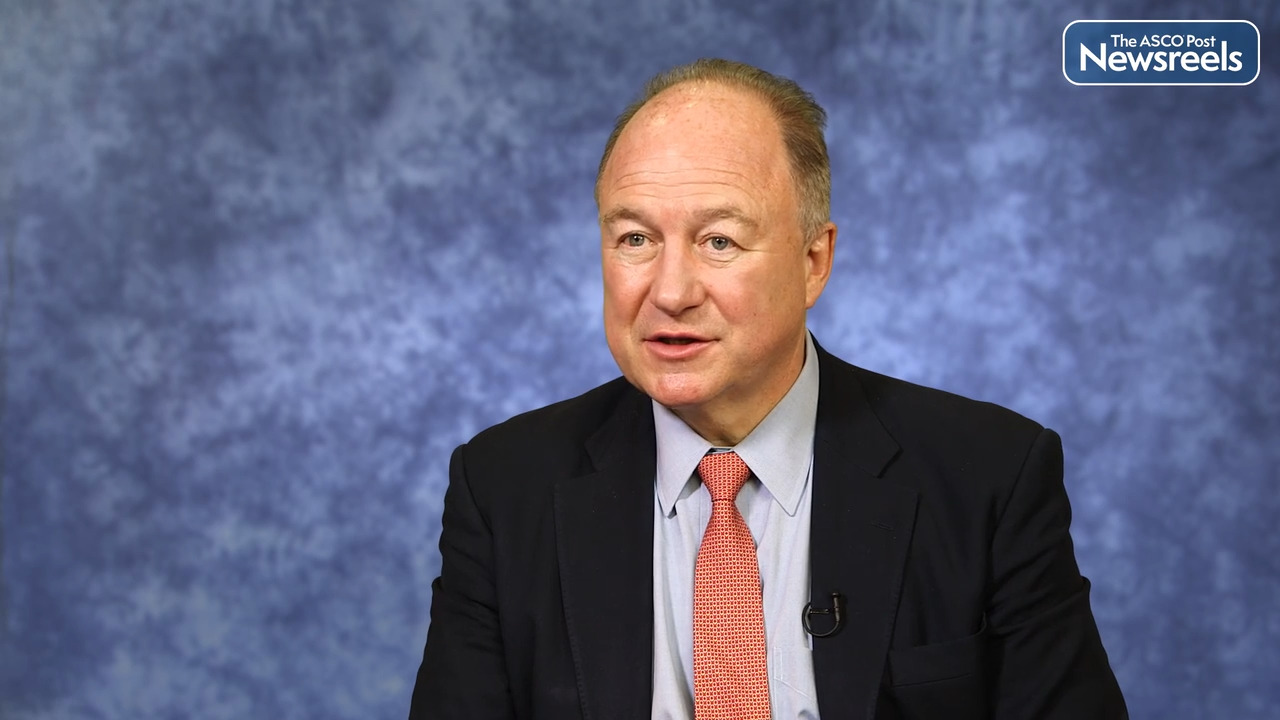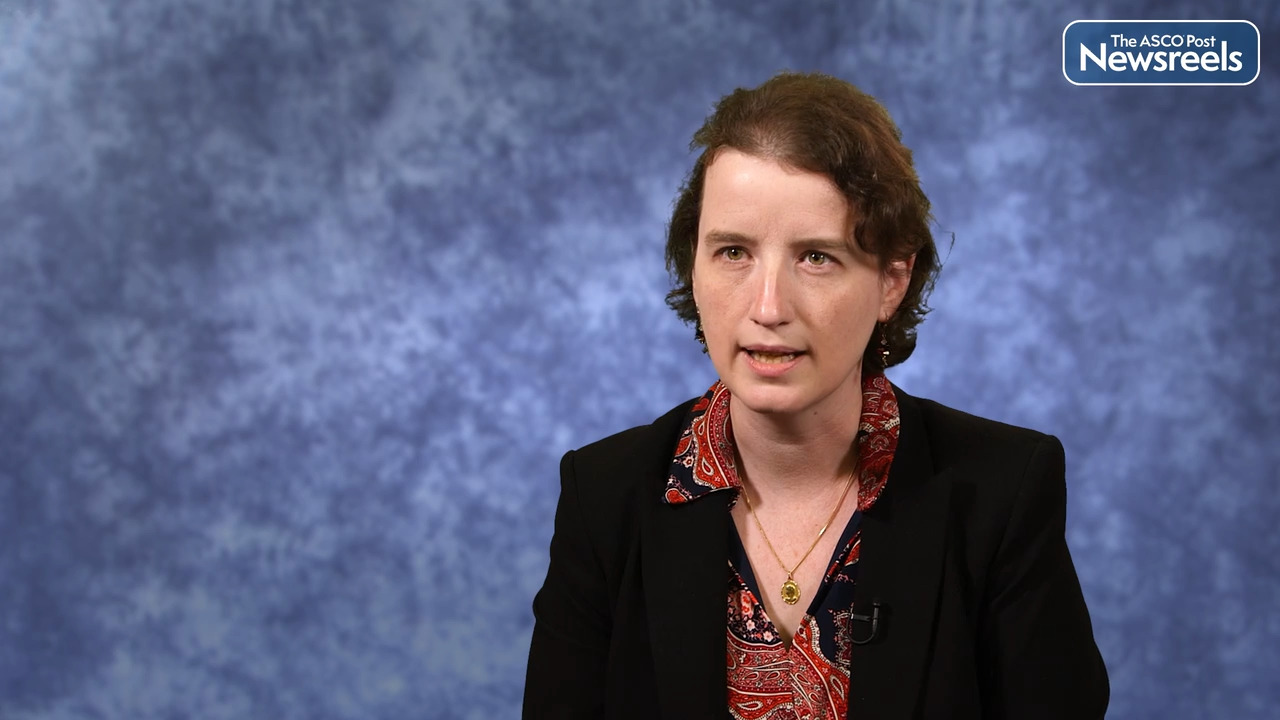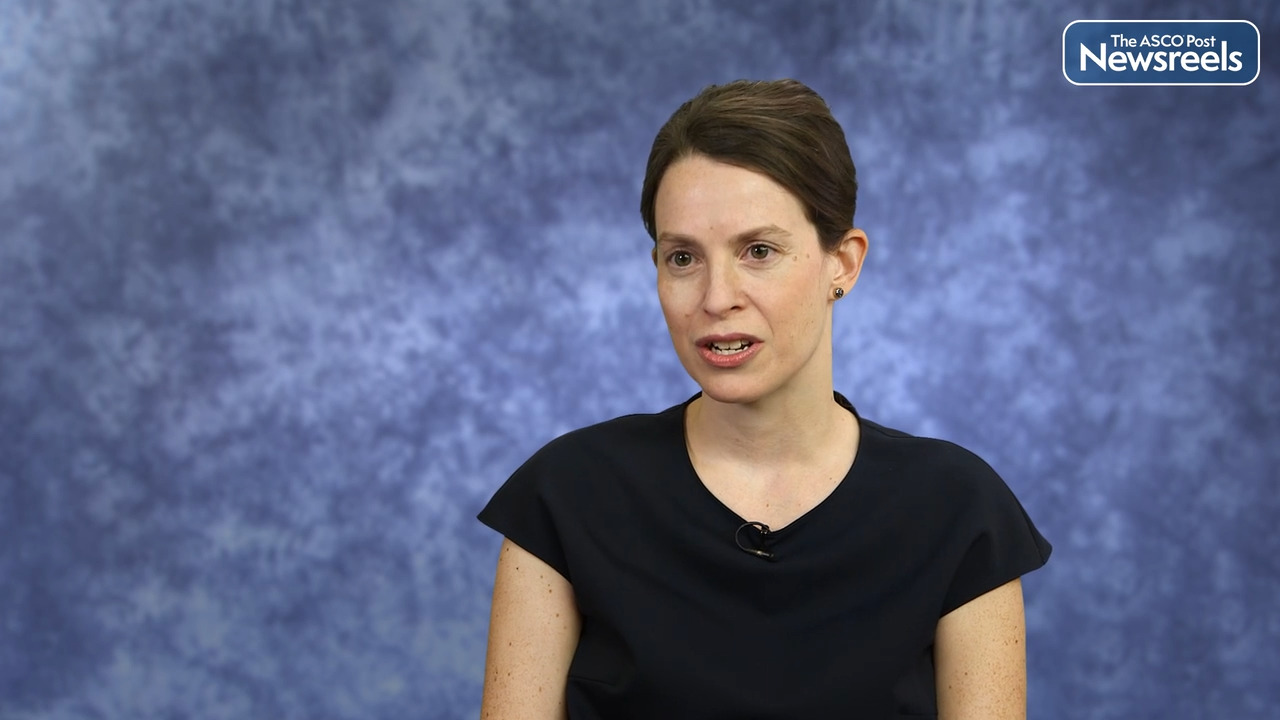Expert Point of View: Robert Rifkin, MD
Smoldering myeloma is an asymptomatic plasma cell disorder with a heterogeneous clinical behavior. Two trials presented at the 2022 American Society of Hematology (ASH) Annual Meeting and Exposition investigated early intervention for smoldering multiple myeloma, aiming for a “curative strategy”...
Triplet and Quadruplet Regimens in Smoldering Multiple Myeloma
Combination regimens beyond lenalidomide/dexamethasone were shown to significantly delay—and potentially prevent altogether—progression from smoldering disease to active multiple myeloma, according to researchers who reported findings from two studies at the 2022 American Society of Hematology...
Study Shows Activity of Talquetamab in Highly Refractory Multiple Myeloma
In the phase I/II MonumenTAL-1 trial, the novel bispecific antibody talquetamab produced responses in more than 70% of heavily pretreated patients with multiple myeloma.1 Of note, the safety profile confirmed results of the phase I portion of the study (recently published in TheNew England Journal...
Expert Point of View: Urvi A. Shah, MD
Urvi A. Shah, MD, Assistant Attending at Memorial Sloan Kettering Cancer Center and Assistant Professor at Weill Cornell Medicine, New York, moderated the session where the MagnetisMM trial updates1,2 were reported and was interviewed by The ASCO Post. Elranatamab vs Teclistamab Dr. Shah noted...
Expert Point of View: Urvi A. Shah, MD
Urvi A. Shah, MD, Assistant Attending at Memorial Sloan Kettering Cancer Center and Assistant Professor at Weill Cornell Medicine, New York, moderated the session where the MagnetisMM trial updates1,2 were reported and was interviewed by The ASCO Post. Elranatamab vs Teclistamab Dr. Shah noted...
Elranatamab Induces Responses in Many Patients With Resistant Multiple Myeloma in Phase II Trial
The promise of bispecific monoclonal antibodies in multiple myeloma continues to heighten as yet another one appears to be active. In a study reported at the 2022 American Society of Hematology (ASH) Annual Meeting and Exposition,1 almost two-thirds of patients with triple-refractory disease who...
Significant Benefit With Addition of Daratumumab to Bortezomib/Dexamethasone in Relapsed or Refractory Multiple Myeloma
As reported in the Journal of Clinical Oncology by Pieter Sonneveld, MD, PhD, of Erasmus MC Cancer Institute, Rotterdam, the Netherlands, and colleagues, the final overall survival analysis of the phase III CASTOR trial has shown a significant benefit of the addition of daratumumab to...
Real-World Use of Idecabtagene Vicleucel for Patients With Relapsed or Refractory Multiple Myeloma
In a retrospective study of the real-world use of idecabtagene vicleucel reported in the Journal of Clinical Oncology, Hansen et al found that response rates and toxicity in patients with relapsed or refractory multiple myeloma were comparable to those in the pivotal phase II KarMMa trial; the...
ASH 2022: Multiple Myeloma Highlights
The 2022 American Society of Hematology (ASH) Annual Meeting and Exposition was full of interesting abstracts in multiple myeloma. In addition to full coverage of several important presentations, The ASCO Post offers readers quick takes on some studies that could be practice-changing and others...
Study Shows Activity of Talquetamab in Highly Refractory Multiple Myeloma
In the phase I/II MonumenTAL-1 trial, the novel bispecific antibody talquetamab produced responses in more than 70% of heavily pretreated patients with multiple myeloma.1 Of note, the safety profile confirmed results of the phase I portion of the study (recently published in TheNew England Journal...
Carfilzomib, Lenalidomide, and Dexamethasone vs Lenalidomide in Maintenance Therapy After ASCT in Newly Diagnosed Multiple Myeloma
As reported in The Lancet Oncology by Dominik Dytfeld, MD, PhD, and colleagues, an unplanned interim analysis of the phase III ATLAS trial has shown improved progression-free survival with carfilzomib, lenalidomide, and dexamethasone (KRd) vs lenalidomide alone as maintenance after autologous stem...
POLLUX Trial Final Overall Survival Analysis: Addition of Daratumumab to Lenalidomide/Dexamethasone in Previously Treated Patients With Multiple Myeloma
As reported in the Journal of Clinical Oncology by Meletios A. Dimopoulos, MD, and colleagues, the final overall survival analysis of the pivotal phase III POLLUX trial has shown a significant benefit with the addition of daratumumab to lenalidomide and dexamethasone after a median follow-up of...
FORTE Trial of Carfilzomib-Containing Induction, Consolidation, and Maintenance in Newly Diagnosed Multiple Myeloma: Subgroup Analysis by Cytogenetic Risk
In a prespecified analysis of the Italian phase II FORTE trial reported in The Lancet Oncology, Mina et al identified outcomes associated with the number of high-risk cytogenetic abnormalities (HRCAs) across treatment groups receiving carfilzomib-containing induction, consolidation, and maintenance ...
Paul G. Richardson, MD, on Multiple Myeloma: Mezigdomide Plus Dexamethasone in Relapsed and Refractory Disease
Paul G. Richardson, MD, of the Dana-Farber Cancer Institute, discusses preliminary results from the dose-expansion phase of the CC-92480-MM-001 Trial, which showed promising efficacy in patients with relapsed and refractory multiple myeloma, including those with prior BCMA-targeted therapies. Patients in these two groups had an overall response rate of 40% and 50%, respectively. The results support the development of mezigdomide, currently being evaluated in combination with standard therapies in multiple myeloma as part of a large, ongoing phase I/II trial (NCT03989414) and planned phase III studies (Abstract 568).
Modakafusp Alfa May Be Effective at Treating Patients With Multiple Myeloma
The novel drug modakafusp alfa has shown early promise in combating relapsed/refractory multiple myeloma, according to new findings presented by Vogl et al at the 2022 American Society of Hematology (ASH) Annual Meeting and Exposition (Abstract 565). Background Modakafusp alfa is a fusion protein...
Genome Sequencing of Circulating Tumor Cells in Detection of Myeloma and Precursor Conditions
The novel MinimuMM-seq technique may make it possible to detect tumor cells in individuals at higher risk for multiple myeloma, assess the risk of disease progression in patients with myeloma, and track genetic changes in tumor cells over time from a single blood sample, according to a new study...
Jiye Liu, PhD, on Multiple Myeloma: Genome-Wide CRISPR-Cas9 Screening Identifies KDM6A as a Modulator of Daratumumab Sensitivity
Jiye Liu, PhD, of Dana-Farber Cancer Institute, discusses study findings that demonstrate KDM6A regulates CD38 and CD48 expression in multiple myeloma. Dr. Liu’s team validated combination treatment with an FDA-approved EZH2 inhibitor plus daratumumab, which can overcome daratumumab resistance in preclinical multiple myeloma models, providing the rationale for combination clinical trials to improve patient outcome (Abstract 148).
Francesco Maura, MD, on Genomic Determinants of Resistance in Newly Diagnosed Multiple Myeloma Treated With Targeted Immunotherapy
Francesco Maura, MD, of the University of Miami, Sylvester Comprehensive Cancer Center, discusses his team’s findings in which they defined a comprehensive catalogue of genomic determinants of response to DKRd (carfilzomib, lenalidomide, dexamethasone) in newly diagnosed multiple myeloma. The researchers have identified a number of new genomic alterations that explain resistance to the agents currently used in combination regimens (Abstract 470).
Eileen M. Boyle, MD, PhD, on Multiple Myeloma: Sustained MRD Negativity in Newly Diagnosed Disease Treated with Immunotherapy Regimens
Eileen M. Boyle, MD, PhD, of the Perlmutter Cancer Center, NYU Langone Health, discusses Fc-mediated antibody effector function, inflammation resolution, and oligoclonality and their role in predicting sustained measurable residual disease negativity in patients with newly diagnosed multiple myeloma who were treated with immunotherapy regimens. For the first time, an analysis of T-cell receptors shows that oligoclonal profiles seen on treatment may influence the fitness of the immune response (Abstract 100).
Julie Côté, MD, on Multiple Myeloma: Real-World Results of Autologous Stem Cell Transplantation in Newly Diagnosed Patients
Julie Côté, MD, of CHU de Québec–Université Laval, discusses findings from the Canadian Myeloma Research Group database, which showed that integrating bortezomib and lenalidomide into the autologous stem cell transplant (ASCT) sequence produces a median overall survival rate ≥ 10 years in most patients with newly diagnosed multiple myeloma. These observations highlight the contribution of post-ASCT maintenance, particularly lenalidomide given until disease progression, when used in multiple patient groups including those with and without high risk, as well as those requiring a second induction regimen (Abstract 117).
Talquetamab Generates High Response Rate in Relapsed or Refractory Multiple Myeloma
In an early-phase trial, nearly three-quarters of patients who received talquetamab—a first-in-class, off-the-shelf, T-cell–redirecting bispecific antibody targeting both the GPRC5D and CD3 receptors—for relapsed or refractory multiple myeloma saw a significant reduction in cancer burden within a...
Teclistamab in the Treatment of Relapsed or Refractory Multiple Myeloma
On October 25, 2022, the bispecific B-cell maturation antigen (BCMA)-directed CD3 T-cell engager teclistamab-cqyv was granted accelerated approval for the treatment of adults with relapsed or refractory multiple myeloma who have received at least four prior lines of therapy, including a proteasome...
Addition of Daratumumab to Bortezomib Plus Dexamethasone in Relapsed or Refractory Multiple Myeloma: CASTOR Trial Final Overall Survival Analysis
As reported in the Journal of Clinical Oncology by Sonneveld et al, the final overall survival analysis of the phase III CASTOR trial has shown a significant overall survival benefit with daratumumab plus bortezomib/dexamethasone (D-Vd) vs bortezomib/dexamethasone alone (Vd) in patients with...
Presence of Small Subclonal Populations of High-Risk Genetic Events at Diagnosis in Multiple Myeloma
In a study reported in the Journal of Clinical Oncology, Lannes et al found that single-cell genomics could identify the presence of high-risk copy number abnormalities (CNAs) in small subclonal populations at diagnosis of multiple myeloma in many patients. The investigators stated, “Multiple...
Teclistamab-cqyv in the Treatment of Relapsed or Refractory Multiple Myeloma
On October 25, 2022, the bispecific B-cell maturation antigen (BCMA)-directed CD3 T-cell engager teclistamab-cqyv was granted accelerated approval for the treatment of adults with relapsed or refractory multiple myeloma who have received at least four prior lines of therapy, including a proteasome...
Study Shows That Immune Cells May Help Identify Patients With High-Risk Smoldering Myeloma Most Likely to Benefit From Treatment
For many patients who have smoldering myeloma, early treatment can slow or delay the disease’s progression to multiple myeloma, according to a new study published by Sklavenitis-Pistofidis et al in Cancer Cell. Investigators demonstrated that changes in immune system cells may indicate which cases...
Proposed Threshold for Circulating Tumor Plasma Cells to Define Plasma Cell Leukemia–Like Multiple Myeloma
In a study reported in the Journal of Clinical Oncology, Jelinek et al provided evidence that a threshold of ≥ 2% circulating tumor plasma cells (CTCs) defines the presence of plasma cell leukemia (PCL)-like multiple myeloma. As stated by the investigators, “Primary PCL is the most aggressive...
Potential Treatment Options for Patients With Relapsed Multiple Myeloma Following CAR T-Cell Therapy
Researchers have identified potential therapies to treat patients with multiple myeloma whose cancer has relapsed following chimeric antigen receptor (CAR) T-cell therapy, according to a novel study published by Van Oekelen et al in Blood. CAR T-cell therapy has been a revolutionary treatment for...
Ciltacabtagene Autoleucel in Relapsed or Refractory Multiple Myeloma
In a Chinese phase II trial (CARTIFAN-1) reported in the Journal of Clinical Oncology, Mi et al found that the anti–B-cell maturation antigen chimeric antigen receptor (CAR) T-cell therapy ciltacabtagene autoleucel was active in patients with relapsed or refractory multiple myeloma. Study Details...
FDA Approves Teclistamab-cqyv for Relapsed or Refractory Multiple Myeloma
On October 25, the U.S. Food and Drug Administration (FDA) granted accelerated approval to teclistamab-cqyv (Tecvayli), the first bispecific B-cell maturation antigen (BCMA)-directed CD3 T-cell engager, for adult patients with relapsed or refractory multiple myeloma who have received at least four...
GPRC5D-Targeted CAR T-Cell Therapy in Heavily Pretreated Patients With Multiple Myeloma
In a single-institution phase I study reported in The New England Journal of Medicine, Sham Mailankody, MBBS, and colleagues found that chimeric antigen receptor (CAR) T cells targeting G protein–coupled receptor, class C, group 5, member D (GPRC5D) were active in heavily pretreated patients with...
Patients With Multiple Myeloma May Face CAR T-Cell Shortages
From microchips to automobiles, people in the United States are experiencing shortages of all kinds of products, and oncology treatments are no exception. In particular, shortages related to chimeric antigen receptor (CAR) T-cell therapy have been reported, most acutely, for B-cell maturation...
Novel Photon-Counting CT May Improve Myeloma Bone Disease Detection
New computed tomography (CT) technology paired with artificial intelligence (AI)-based noise reduction may offer superior detection of bone disease associated with multiple myeloma at lower radiation doses than conventional CT, according to a recent study published by Baffour et al in Radiology....
Bispecific Antibodies and the Dawn of a New Era in Treatment of Multiple Myeloma
“I think the biggest innovations of the 21st century will be at the intersection of biology and technology. A new era is beginning!” —Steve Jobs Relapsed and refractory multiple myeloma remains a treatment challenge. Promising responses have been demonstrated with bispecific antibodies, with a...
Study Examines Efficacy of T-Cell Redirection Therapies for Patients With Relapsed Multiple Myeloma
Mount Sinai researchers have published results that show alternate therapeutic options for patients with multiple myeloma after first-line treatment with bispecific antibodies fails. While new T cell–based immunotherapies, or “T-cell redirection” therapies, such as chimeric antigen receptor (CAR)...
BCMA x CD3 Bispecific T-Cell Redirecting Antibody ABBV-383 in Relapsed or Refractory Multiple Myeloma
In a phase I trial reported in the Journal of Clinical Oncology, D’Souza et al found that the B-cell maturation antigen (BCMA) x CD3 bispecific T-cell redirecting antibody ABBV-383 was active in patients with relapsed or refractory multiple myeloma. Study Details In the ongoing trial, 124 patients...
Final Analysis of GRIFFIN Study Presented for Daratumumab-Based Investigational Quadruplet Regimen in Newly Diagnosed, Transplant-Eligible Patients With Multiple Myeloma
The randomized phase II GRIFFIN study evaluated the investigational use of daratumumab in combination with lenalidomide, bortezomib, and dexamethasone (RVd), followed by maintenance therapy with daratumumab and lenalidomide, compared to RVd followed by maintenance therapy with lenalidomide alone,...
Durability of Responses to BCMA CAR T-Cell Therapy in Patients With Multiple Myeloma May Depend on Specific Components of the Tumor Microenvironment
Currently, there are two U.S. Food and Drug Administration–approved chimeric antigen receptor (CAR) T-cell therapies targeting the B-cell maturation antigen (BCMA) for adult patients with relapsed or refractory multiple myeloma: idecabtagene vicleucel and citacabtagene autoleucel. However, although ...
Prevalence of MGUS Among Rescue and Recovery Workers Exposed to the World Trade Center Disaster
In an observational seroprevalence study reported in Blood Cancer Journal, Zeig-Owens et al found an elevated prevalence of myeloma precursor disease—monoclonal gammopathy of undetermined significance (MGUS)—in a cohort of World Trade Center (WTC) disaster–exposed rescue and recovery workers....
Racial/Ethnic Representation in Pivotal Clinical Trials for Drugs Approved for Leukemias and Multiple Myeloma
In a study reported in the Journal of Clinical Oncology, Casey et al found that most U.S. minority populations were underrepresented in clinical trials leading to U.S. Food and Drug Administration approval of drugs for treating leukemias and multiple myeloma. Study Details The investigators...
Elotuzumab Plus Pomalidomide/Dexamethasone in Patients With Relapsed or Refractory Multiple Myeloma: ELOQUENT-3 Overall Survival Analysis
As reported in the Journal of Clinical Oncology by Meletios A. Dimopoulos, MD, and colleagues, the final overall survival analysis of the phase II ELOQUENT-3 trial showed significant benefit with the addition of elotuzumab to pomalidomide and dexamethasone (EPd) vs pomalidomide and dexamethasone...
Is Science Getting Closer to Preventing Multiple Myeloma?
About 3 years ago, researchers from Dana-Farber Cancer Institute launched PROMISE (Predicting Progression of Developing Myeloma in a High-Risk Screen Population; ClinicalTrials.gov identifier NCT03689595), a large, ambitious screening study to identify individuals at high risk of developing...
MRD-Adapted Study of Elotuzumab Plus Carfilzomib, Lenalidomide, and Dexamethasone in Newly Diagnosed Multiple Myeloma Without Transplantation Intent
In a phase II trial reported in JAMA Oncology, Derman et al found that a measurable residual disease (MRD)-adapted strategy with elotuzumab (Elo) plus carfilzomib, lenalidomide, and dexamethasone (KRd) was associated with high rates of stringent complete response and MRD-negative status in patients ...
Peter M. Voorhees, MD, Discusses Results From the ATLAS Trial
The invited discussant of the ATLAS trial, Peter M. Voorhees, MD, Professor of Medicine, Chief of the Plasma Cell Disorders Division, at Levine Cancer Institute and Atrium Health/Wake Forest Baptist in North Carolina, applauded the very good outcomes achieved in the study.1 However, he posed the...
ATLAS Trial: Risk-Adapted Triplet Maintenance Therapy May Benefit Some Patients With Multiple Myeloma
For newly diagnosed patients with multiple myeloma participating in the international phase III ATLAS trial, use of carfilzomib, lenalidomide, and dexamethasone (KRd) as maintenance therapy after induction and autologous stem cell transplantation (ASCT) significantly reduced the risk of disease...
Researchers Find Potential Link Between Genetic Mutations and Treatment Resistance in Patients With Relapsed or Refractory Multiple Myeloma
Researchers studying the molecular landscape of over 500 patients with relapsed or refractory multiple myeloma discovered a prevalence of activated key oncogenic pathways in these patients—much more than previously thought. Upward of 45% to 65% of NF-κB and RAS/MAPK pathways each had alterations....
Caregivers for Patients With Multiple Myeloma Face Mental Health Challenges
Caregivers for patients with multiple myeloma may suffer from higher rates of anxiety and depression than patients themselves, according to a new study published by O’Donnell in Blood Advances. Although medical professionals have long acknowledged the toll a serious or terminal diagnosis can have...
Responses to Teclistamab Reported in Early-Phase Trial of Highly Refractory Multiple Myeloma
In patients with multiple myeloma exposed or refractory to three standard therapies, treatment with the bispecific antibody teclistamab produced strong and durable responses in the phase I/II MajesTEC-1 study.1 The results of weekly subcutaneous dosing of teclistamab in 165 patients were presented...
CAR T-Cell Therapy Gave Me Back a High-Quality Life
A radiologist by training, I knew the minute I saw the results from my chest x-ray that I had multiple myeloma. In 2015, I was semiretired and had just taken up the game of golf. After making a big swing at the ball, I instantly felt pain in my ribs and thought I had either pulled an intercostal...
Association of CTC Levels With Outcomes in Transplant-Eligible Patients With Newly Diagnosed Multiple Myeloma
In a study reported in the Journal of Clinical Oncology, Bertamini et al found that higher levels of circulating tumor cells (CTCs) at diagnosis were associated with poorer progression-free and overall survival in transplant-eligible patients with newly diagnosed multiple myeloma. The prognostic...





